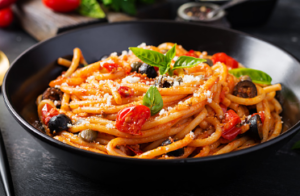If you need to eliminate gluten from your diet, pasta doesn’t have to be sacrificed; these gluten-free versions will still satisfy you without compromising flavour or texture.
Just like regular pasta, these Adelaide pasta gluten-free options should be prepared according to the instructions on their packaging; however, cooking times will depend on the chosen variety.
Choose the Right Shape and Texture
 The shape is essential in how well gluten-free pasta turns out, which is available in nearly every style and cut traditionally available. When choosing what shape of Adelaide pasta gluten-free to cook, keep in mind the types of sauces and ingredients you plan to combine it with; elbow macaroni may work well as an alternative to smaller pasta shapes like couscous or pastina but won’t bear up against larger ingredients like meat crumbles and chopped vegetables.
The shape is essential in how well gluten-free pasta turns out, which is available in nearly every style and cut traditionally available. When choosing what shape of Adelaide pasta gluten-free to cook, keep in mind the types of sauces and ingredients you plan to combine it with; elbow macaroni may work well as an alternative to smaller pasta shapes like couscous or pastina but won’t bear up against larger ingredients like meat crumbles and chopped vegetables.
Texture-wise, gluten-free products vary significantly as well. Some are composed entirely of one grain – like brown or white rice – while others feature combinations like quinoa and corn. Some recipes even incorporate beans and legumes for extra nutrition!
Consideration must also be given when purchasing Adelaide pasta gluten-free regarding its cooking time. Most gluten-free noodles tend to cook faster due to not needing gluten molecules for structure. For best results, follow all directions on the package closely and stir frequently during its process to prevent overcooking of the pasta.
Find the Right Brand
Gluten is a protein found in wheat and its related grains like barley, rye and spelt, giving pasta its distinctive structure and satisfyingly chewy texture. People may opt to avoid gluten for various reasons, and fortunately, numerous pasta brands offer gluten-free versions so everyone can enjoy eating pasta!
Most gluten-free pastas are composed of one or a combination of alternative flours. Rice flour is one option; other brands use potato starch/tapioca flour, corn flour/cornstarch, quinoa flour or even legume flours such as black bean, mung bean, chickpea and lentil to craft their product. In addition, there’s even the rare fibre called glucomannan, which comes from the Asian konjac yam’s root.
If you’re shopping for gluten-free pasta, start by reviewing your top options and considering which aspects matter most – taste, nutrition or price. From there, you can narrow your choices until you find what is perfect.
Know the Ingredients
Pasta is a beloved food among those with celiac disease or gluten sensitivity, yet they may find it difficult to find satisfying alternatives to wheat-based pasta dishes.
If you’re searching for healthier pasta options, choose gluten-free varieties made with brown rice and quinoa-based pasta. These are lower in calories than wheat-based options and are a rich source of fibre, iron and B vitamins!
Another nutritious gluten-free pasta made from yellow pea flour offers 7 grams of protein and 12 grams of fibre in every two-ounce serving, called ZENB pasta. Available in spaghetti, penne, elbows and rotini shapes, organic, non-GMO, vegan dairy-free!
Try Something New
Gluten-free pasta offers an exciting opportunity to discover new shapes, textures, and flavours while improving its nutritional value. Some gluten-free pasta options boast high amounts of protein and fibre – ideal for refuelling after an intensive workout – such as Barilla’s red lentil rotini, which provides fibre and protein content.
Other brands of gluten-free pasta offer varieties made with multiple gluten-free grains, like rice and corn, legumes or quinoa – adding more variety of taste while upping both carbs and calories slightly.
Nutrition
Many gluten-free pastas are enriched with nutrients like vitamin D, which supports bone health, and iron, which contributes to normal red blood cell production. These added vitamins are important for everyone, especially those who follow a gluten-free diet.
The nutritional content of gluten-free pasta varies depending on the type of flour used to make it. Corn and rice flours most closely resemble wheat-based pasta, but products made from legumes, such as yellow peas and green lentils, tend to have more protein than grain-based options.
While wheat-free pasta can cause allergies and intolerances, such as itching and mouth irritation, other gluten-free noodles can be nutritious and enjoyable for people with dietary restrictions. For example, Tolerant Foods makes green lentil animal pasta, a fun way to add fibre and protein to your kids’ meals in a cute package. Their chickpea alphabet and buckwheat galaxy pasta also have good amounts of protein.
 When selecting a www.markwellfoods.co.nz/tradeexport frozen food wholesaler, they must offer high-quality frozen products. A low-grade supplier could compromise your business’s reputation, image, and customer trust.
When selecting a www.markwellfoods.co.nz/tradeexport frozen food wholesaler, they must offer high-quality frozen products. A low-grade supplier could compromise your business’s reputation, image, and customer trust.